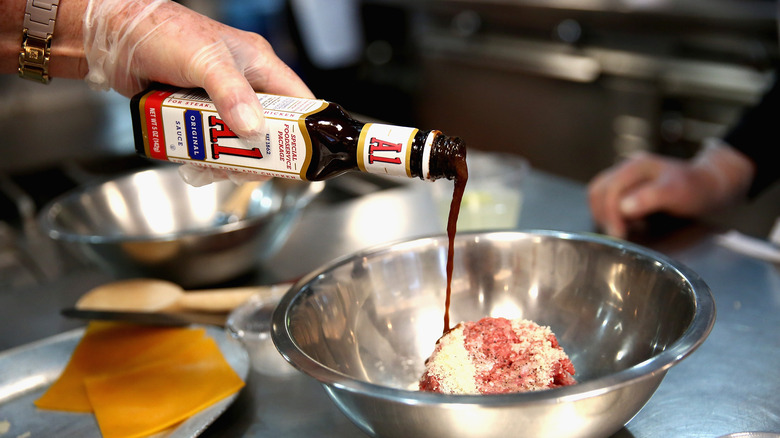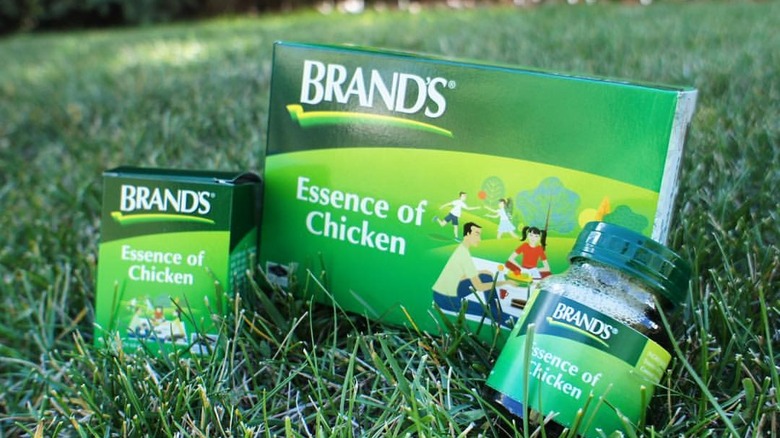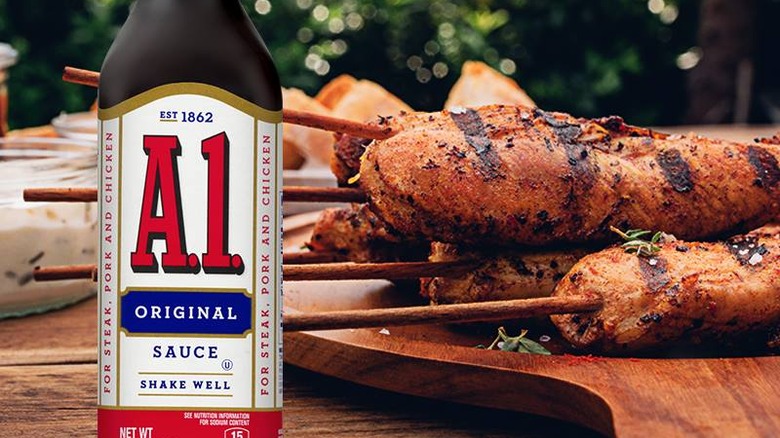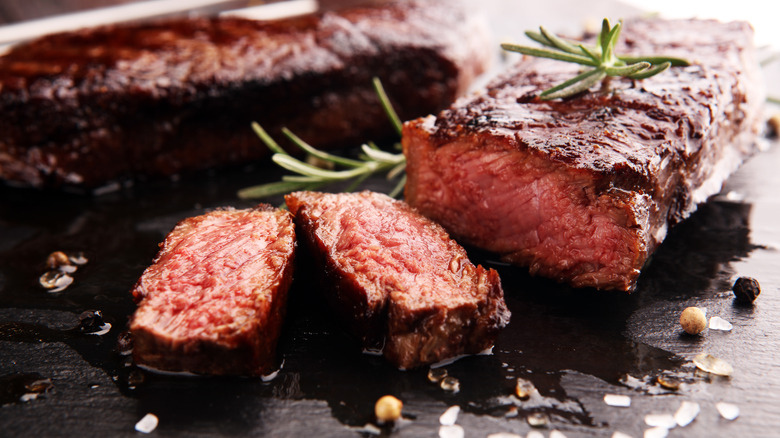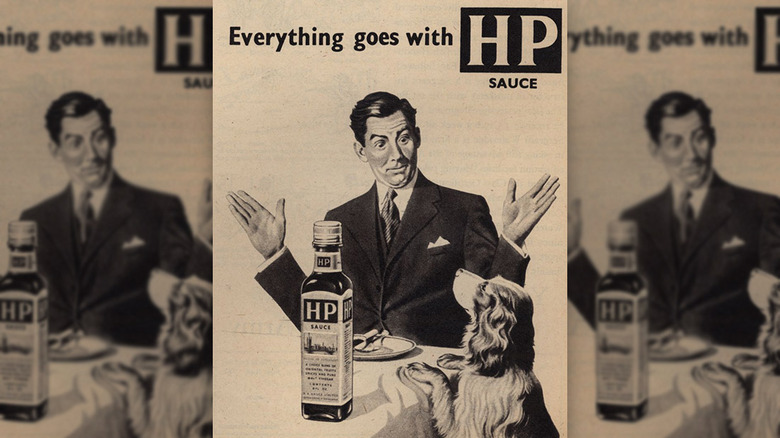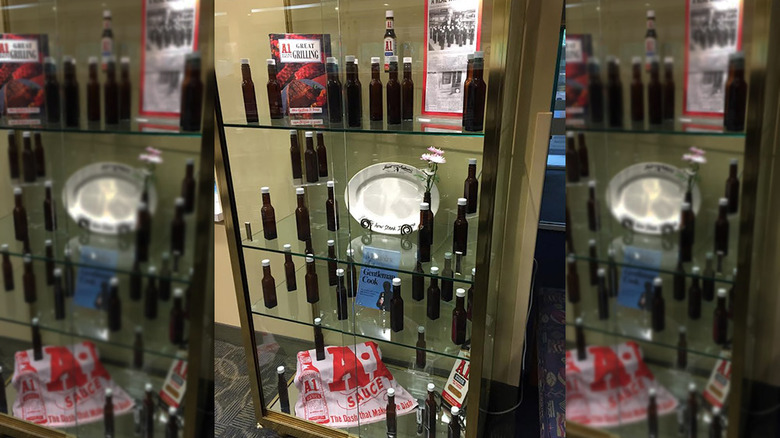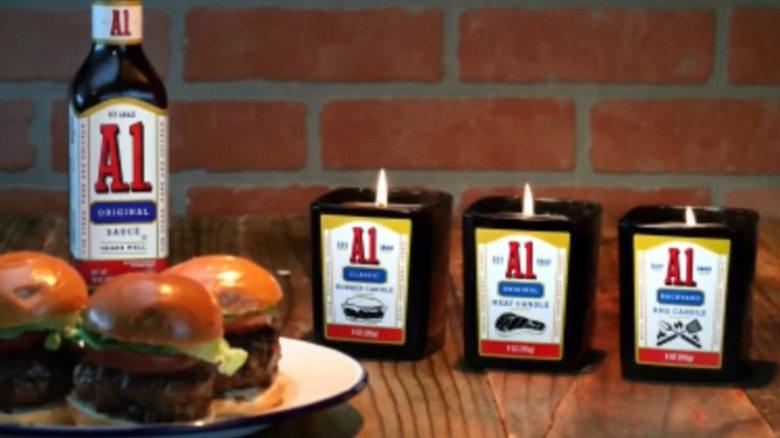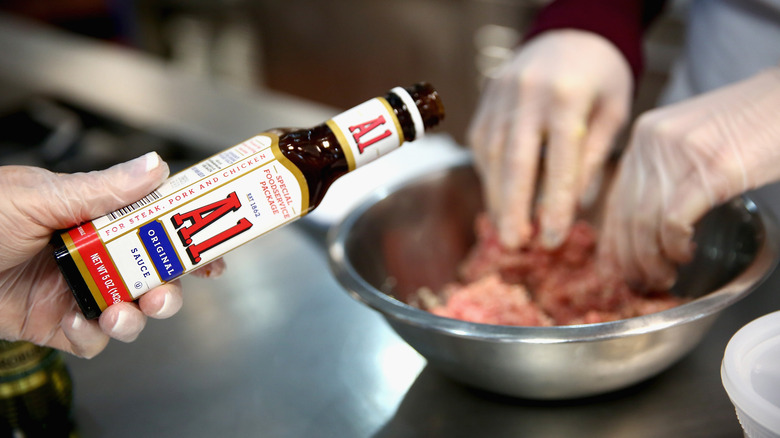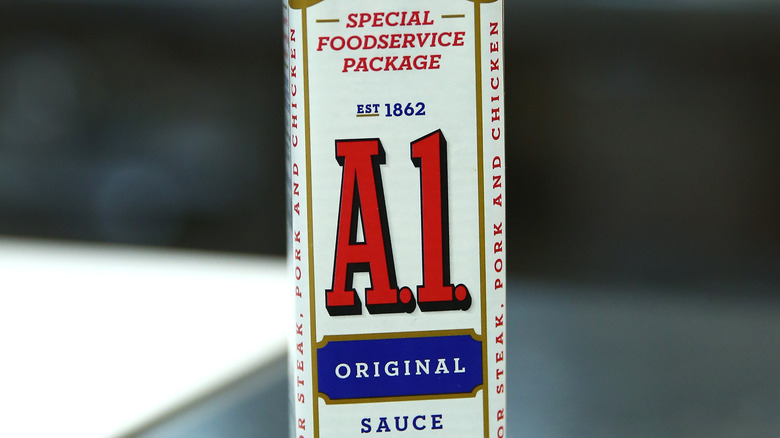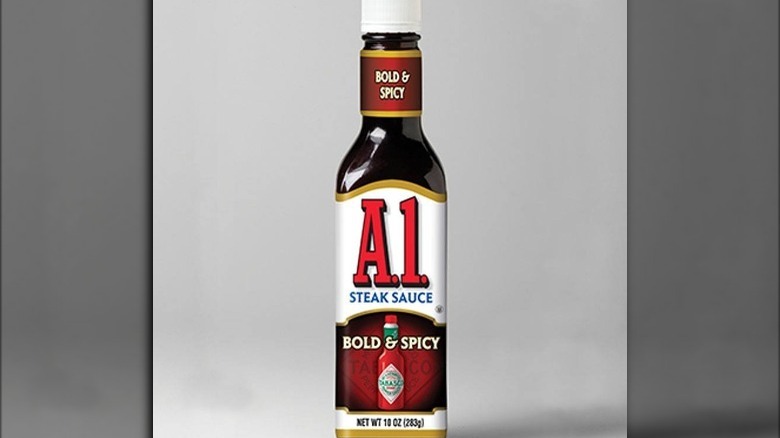The Untold Truth Of A.1. Sauce
A.1. Sauce, also known as A.1. Steak Sauce, also known as just "steak sauce," because, much like Kleenex, Xerox, and Band-Aid, the A.1. brand has become synonymous with steak sauce. Sure, there's a peppercorn sauce, a zesty chimichurri, or a red wine sauce, but if you ask for a bottle of steak sauce, you're getting A.1., whether you like it or not.
Suppose, much like other iconic brands, A.1. gave its classic square bottles a makeover, maybe tried to jazz up the chunky font or the slogan of "original sauce," well, that just wouldn't seem quite right. It's steak sauce, the absolute antithesis of hipster foodie culture. It looks like a time capsule, it tastes like a time capsule, and it is just fine as it is, thank you very much. But why is it called something that sounds like a copy tray size? And was it really, as the label claims, "established in 1862"? Let's get to know our friend, the ever-reliable A.1., a bit better, shall we?
A.1. Sauce was invented by Henderson William Brand
A.1. Sauce was first invented by Henderson William Brand, a personal chef for King George the IV from 1824 to 1831. Supposedly, King George tasted the sauce and voiced his approval by pronouncing it "A1." Henderson William Brand was born in Durham, a city in north east England, and was the son of Thomas Brand, an innkeeper and brewer. While no one knows for sure if a young Henderson William Brand worked in his father's kitchen, it seems likely, because at the tender age of 12 he was working in the kitchen of the Prince Regent as an "undercook." The Prince Regent, known as a gastronome with a taste for haute cuisine, became King George IV in 1820, and Henderson William Brand went from undercook to "yeoman of the mouth," a position akin to that of a sous chef, shortly after.
Brand would later publish an updated version of Simpson's Cookery, a popular cookbook at the time, and set up a shop in London in 1835. His first two products were Essence of Chicken and Essence of Beef. After declaring bankruptcy, rebranding, and trading as "H.W. Brand," Brand was appointed the cook and manager of cuisine at the 1862 International Exhibition in London, where he debuted "Brand's International Sauce," where it was ranked, unsurprisingly, A1.
A.1. Sauce's ingredients helped to hide the taste of old beef
For a sauce that has existed in some form or another since 1862, A.1. has a pretty unsurprising list of ingredients, with a few exceptions. Notable among them is raisin paste, H.W. Brand's stroke of genius that has been used in other sauces and prepared foods ever since. The antioxidants in raisins helped slow the decay of beef in the days before refrigeration, but also helped mask the taste of decaying beef. Apparently, even kings weren't too regal to not eat some funky steak in the 1860's.
Distilled vinegar also has a utility beyond taste: it's the world's oldest meat tenderizer. In its earliest inception, A.1. Sauce used the more expensive malt vinegar. Older versions of the sauce also used orange marmalade instead of orange puree. The spices and herbs are a trade secret, of course. It's safe to say that in H.W. Brand's day there was no corn syrup, caramel color, or xanthan gum. If the idea of eating a slightly less processed, shelf-stabilized version of A.1. appeals to you, try this copy-cat recipe.
A.1. Sauce's parent company produces a popular Asian health supplement
Kraft foods owns the license for Nabisco, which includes the license for the A.1. brand in North America, and the parent company for Brand & Co, Cerebos, produces A1 in the U.K. for export to European and Asian markets. The steak sauce, however, is not Brand & Co's most popular product.
Essence of Chicken, a health supplement made from chicken, is widely popular in Asia and is often touted as a "brain tonic" that can help with studying and cognitive development. Brand first developed the recipe for the ailing King George IV. While working in the royal kitchen, Brand created a chicken-based health tonic for the king, which he then went on to sell to the public. The monarchy issued a royal warrant for the product 1897, essentially endorsing Essence of Chicken, and the product initially was exported to Asia in the 1920s.
Essence of Chicken has been the subject of a few clinical trials and studies to measure any possible effects on cognitive function and has actually been found to provide measurable benefits. As for A.1. well, its only benefit seems to be the flavor.
A.1. Sauce dropped "steak" from its name in 2014
Kraft Foods Group dropped the "steak" from the iconic steak sauce brand's name in 2014 and brought it back to the TV ad airwaves after a five-year absence to announce the split. Why was A.1. steak sauce no longer just for steak? Among animal proteins consumed at home, beef has been on the decline, while chicken is on the rise. As of 2014, 65 percent of A.1. sauce was slathered on steak and not on another protein source. Clearly a change was needed if A.1 was going to buck the declining popularity of beef. Promoting A.1. as a sauce that can go with, as the ad campaign said, "almost everything," was a way of helping to solidify the brand's long-term survival in a world of changing consumer habits and tastes.
The name change, though, was actually a shift back to A.1.'s original branding and name. A.1. only added steak to its name in the 1960's in a pivotal shift to beef, but it was first marketed as a high-quality, all-purpose "saucy sauce different from any other, appreciated on Welsh rarebits, broiled lobster and English mutton chops."
A.1. Sauce is declining in popularity
But could A.1.'s branding change from "A.1. Steak Sauce" to "A.1. Sauce" be less about hoping pescatarians will pour a little A.1. on their fish tacos and more about the fact that steak sauce overall is losing popularity? For one thing, meat quality has significantly improved since the 1960's peak of steak sauce's popularity, and the need to mask inferior quality beef with sauce has declined. Certified Angus Beef was established in 1978, and consumers' tastes have changed as ranchers have met higher and higher standards. The days of King George masking the taste of slightly rancid beef with sauce are long gone.
Another factor behind the decline of A.1. Sauce is that, on the whole, chefs don't like it, and diners respect chefs. Especially at a high-end restaurant, where the chef composes the entire dish — including any sort of the sauce. To put a big glob of A.1. on a dry-aged rib-eye would, at minimum, raise a few eyebrows in the kitchen.
Although A.1. Sauce was invented in the U.K., it's no longer sold there
Even though A.1. Sauce has the most incredibly British origin story, it is not widely available in the U.K. and instead, only manufactured there for export. A.1. was also known as "A1" without the two periods that are used on the American label, and it was phased out of British supermarkets in the 1970s. Although A.1. is perhaps the only American version of a thick, brown steak sauce, the "brown sauce" market in the U.K. is quite competitive with options such as HP, Daddie's, Heinz Ideal, and Fletcher's Tiger Sauce all vying for the attention of shoppers. HP Sauce — once manufactured in Britain but now made in Holland – accounts for 71 percent of the U.K.'s brown sauce market. A.1./A1 just couldn't keep up with the competition.
You can sometimes find imported American A.1. sauce at larger supermarkets in Britain. And as for the question, are brown sauce and steak sauce the same thing? Nobody has a specific answer, but brown sauce seems to be popular with breakfast, whereas not too many folks are slathering steak sauce on toast.
Empty bottles of A.1. Sauce kept mysteriously appearing at a library in Ohio
In 2017, in the town of Avon Lake, Ohio, an unidentified person with a mysterious motive kept leaving empty bottles of A.1. stashed in different areas of the public library. Employees found the first bottle in the newspaper section, and after that, up to 40 more appeared hidden behind books and plants in the library. All were clean, empty, and had the labels removed. The library's surveillance video didn't reveal the mystery bottle-leaver.
The library employees theorized that the bottles had been used to smuggle in alcohol, but that did not hold up under a smell test. The bottles only smelled of tangy A.1. Sauce, and not of alcohol. The library staff ruled out a teenage culprit, due to the fact that the bottles seemed to be left in the first half of the day. While it might not make for the most exciting story on Unsolved Mysteries, the case of mysterious A.1. bottles of the Avon Lake Public Library remains open.
Nicki Minaj committed the faux pas of using A.1. Sauce at a classy steakhouse
In 2013, rapper Nicki Minaj ate at Boa, a high-end steakhouse in West Hollywood, California. Boa's prices for steak start at $40 for a small filet, and putting steak sauce on an expensive steak can be seen as an insult to the chef. Nicki Minaj obviously marches to the beat of her own drum, because she had someone from her entourage provide her with a bottle of A.1. as soon as she sat down (via TMZ). When a rep for A.1. Sauce saw TMZ's paparazzi footage, they told the celebrity outlet, "We're so glad to hear that Nicki Minaj loves our sauce just as much as we love her and her music. To make sure she's never 'sauceless' again, we sent Nicki some of our A.1. Original Steak Sauce."
Nicki Minaj is not the only celebrity who loves A.1., even if some foodies might consider steak sauce a little gauche. Singer John Legend revealed to Postmates that his famous foodie spouse, Chrissy Teigen, loves the stuff. Apparently, Teigen accidentally placed a Postmates order for 25 bottles of A.1. instead of five. Of Teigen's love for A.1., Legend said, "Chrissy insists on having A1 for her steak no matter how blasphemous that is to any steak people."
A.1. Sauce made meat-scented candles for Father's Day
Home fragrances usually fall into the floral or herbal family: pumpkin spice, vanilla, jasmine, etc. In 2018, however, A.1. Sauce decided to usher in a brave new world in home fragrances by introducing a line of meat-scented candles for Father's Day. The candles were made so that dear old dad doesn't have to "do the whole cooking thing to get the hearty smell." The candles came in three meaty flavors, or rather, scents: Original Meat, Backyard BBQ, and Classic Hamburger. As gimmicky as they were, the candles proved to be pretty popular and sold out in one week – so far, they haven't been restocked. (Sorry, dads who missed out.)
A.1. is not the first or only food brand to venture into the candle-making business either. KFC launched a limited edition gravy-scented candle in 2019, as well as a very limited edition run of SPF 30 sunscreen that smelled like fried chicken in 2016. To support Autism Speaks, White Castle released an Original Slider-scented candle in 2014, and McDonald's debuted its burger-scented candle in February 2020. Taco Bell seemed to toy with the idea back in 2011, but nothing seemed to come of it.
There are countless other culinary uses for A.1. sauce
In 2014, A.1. Steak Sauce axed the "Steak" from its name. It was a move promoting the idea that A.1. could be used on more than just a prime cut of beef. At the time, parent company Kraft unleashed a marketing campaign promoting the use of A.1. with pork, chicken, fish, and vegetables. "Our fans are saucing a variety of foods besides steak, so we wanted the brand name and campaign to reflect our wide-ranging appeal," said Cindy Halvorsen, A.1. Sauce brand manager at the time.
Kraft wasn't alone in realizing A.1. goes well with plenty of other foods. In fact, the general public has devised a host of culinary uses for the sauce over the years. On one Quora thread alone, people have suggested using A.1. as a condiment on baked potatoes and hamburgers, and as a dipping sauce for eggs and French fries. Another popular use is mixing A.1. into a meatloaf mixture. One commenter said she pours some into beef stew, and yet another suggested adding it to Bloody Marys.
For its part, A.1. has gotten into the act. Its Facebook page is filled with dish ideas incorporating the sauce, including everything from nachos to pumpkin seeds.
There was a trademark lawsuit over the A.1. name
Having been around for more than a century, the "A.1." name clearly has some staying power. It shouldn't be surprising then, to see some competitors try to ride the coattails of its success. But for at least one such sauce seller, that meant going further than the law allowed.
In the early 1990s, a Connecticut deli owner named Arnold Kaye was selling his own unique condiment at his store and local retailers. He called the sauce "A.2." Needless to say, this didn't go over well with the people at Nabisco, which owned A.1. at the time. In 1991, the company filed a trademark lawsuit against the Connecticut businessman. Kaye admitted that the name "A.2." was used to piggyback off A.1.'s brand recognition, but he argued the moniker was intended to be a pun. Additionally, since the sauces tasted different, he denied that customers would be confused or believe the two sauces were part of the same product line.
The court wasn't buying it, finding Kaye's argument's "equally unavailing," and ruling in favor of Nabisco. Not only did the court prohibit Kaye from using the A.2. name going forward, but according to the Metropolitan News-Enterprise, he was ordered to recall all bottles that were on shelves at the time and have them destroyed.
You can find A.1. in Canada, but it won't taste the same
If you happen to find yourself north of the border with a hankering for A.1. sauce, you're in luck — well, kind of. You see, Kraft, which owns A.1., does sell the sauce in Canada. The problem is, it won't taste anything like the A.1. you're used to here in the United States.
A quick look at the ingredient list of both the American and Canadian versions shows that the two sauces are concocted from distinctly different recipes. While both are made from a tomato puree base and contain orange and raisin flavorings, vinegar, and salt, there are some notable differences between the two. The Canadian version is heavy on the sweet stuff — it's made with sugar, caramel, and molasses. The U.S. takes a different direction, deriving its flavor, in part, from dried onion and garlic. American A.1. sauce also uses caramel coloring, so it has the same look but none of the sweetness.
There are more differences between these two neighboring A.1. versions. An intrepid YouTuber found that the Canadian sauce has a much thicker consistency, while the American iteration is a bit runny. Finally, there's the bottle and label. North of the border, the sauce comes in a squeeze bottle, much like one would see with ketchup, unlike the American twist-cap bottle. Also, for reasons unknown, the sauce in Canada is labeled "A1" without the periods.
Singer Meat Loaf appeared in a famous A.1. commercial
It's no secret that A.1. sauce makes for an excellent, spicy addition to any meatloaf recipe. Well, in 2009, the steak sauce makers took that little factoid to the next level when they recruited Meat Loaf the singer to appear in an A.1. commercial.
In the commercial, Meat Loaf whips up a batch of the eponymous dish and drizzles on some A.1. sauce before digging in. The rock singer enjoys his first bite so much he begins belting out his famous song "I'd Do Anything for Love." Meat Loaf does make one important tweak to the song lyrics, however. Instead of singing the refrain, "But I won't do that," he sings, "And I always do this," as he pours A.1. from a giant-sized bottle onto his meatloaf.
It turns out the steak sauce partnered with Meat Loaf at just the right time in his life. According to the Mirror, the singer was previously a vegetarian for 11 years. In addition, just last year, he went vegan to celebrate Veganuary, a U.K.-based challenge to cut out animal products from your diet for the month of January.
There are numerous varieties of A.1. sauce
A.1. sauce has been around for a really long time, so it's safe to say that people enjoy the taste of the original recipe. But that doesn't mean the makers of the popular condiment are resting on their laurels. In fact, Kraft, which owns A.1., continues to come up with new varieties of the nearly 160-year-old sauce.
Included in this list is A.1. Sweet Chili Garlic sauce, which contains mildly spicy cayenne pepper, red bell pepper, and traces of garlic. Kraft recommends using this with chicken nuggets or buffalo wings. There's also A.1. Bold and Spicy, made with Tabasco Sauce, and A.1. Sweet Hickory, which includes Bull's-Eye BBQ sauce in its recipe. For those looking for a peppery tang, A.1. offers a Smoky Black Pepper variety, while the Spicy Chipotle sauce delivers a decidedly Mexican flavor profile.
But that's not all. A.1. has expanded its product line to include marinades (maybe they heard that the original sauce is commonly used for such a purpose). There are a wide variety of marinade flavors including Classic, New York Steakhouse, Chicago Steakhouse, Texas Mesquite, and New Orleans Cajun.
You can use A.1. for household tasks
When A.1. took the "steak" off its name in 2014, it simultaneously unveiled a new tag line: "For almost everything. Almost." We're pretty sure they meant for almost any food. But some have taken a few creative liberties with the tagline, using A.1. sauce for a variety of household tasks.
According to FoodReference.com, one of the most common uses for A.1. sauce outside of the kitchen is in polishing metal. Why, you ask? Because of the ingredients found inside the condiment. A.1. sauce contains both vinegar and tomato paste, two acidic ingredients. Acid can help dissolve tarnish off of metals. Therefore, vinegar and tomatoes are often used to polish copper, brass, and silver.
But there's more. FoodReference.com also mentions that A.1. sauce can be used to shine shoes (an idea backed up by some Reddit users) and repair scratches on wood furniture. But the most unique A.1. claim is that it can be used to relieve bug bites. How this idea came to be — and whether or not it's accurate — isn't clear but it likely stems again from sauce's vinegar, which is known to cool skin and reduce burning and stinging.
